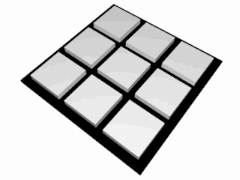|
|
|
Math Games |
|
|
|
Tower of Trans.
|
Play
Game |
|
Where's the Math
in this Game?
 The number of
separate transfers of single disks the priests must make to
transfer the tower is 2 to the 64th minus 1, or
18,446,744,073,709,551,615 moves! If the priests worked day
and night, making one move every second it would take slightly
more than 580 billion years to accomplish the job! You have a
great deal fewer disks than 64 here. Can you calculate the
number of moves it will take you to move the disks from one of
the three poles to another? The number of
separate transfers of single disks the priests must make to
transfer the tower is 2 to the 64th minus 1, or
18,446,744,073,709,551,615 moves! If the priests worked day
and night, making one move every second it would take slightly
more than 580 billion years to accomplish the job! You have a
great deal fewer disks than 64 here. Can you calculate the
number of moves it will take you to move the disks from one of
the three poles to another?
The objective of
the puzzle is to move the entire stack to another rod, obeying
the following rules:
Only one disk must
be moved at a time.
Each move consists
of taking the upper disk from one of the rods and sliding it
onto another rod, on top of the other disks that may already
be present on that rod.
No disk may be
placed on top of a smaller disk.
With three disks,
the puzzle can be solved in seven moves.
Alternating between the smallest and the next-smallest disks,
follow the steps for the appropriate case:
For an even number of disks:
- make
the legal move between pegs A and B
- make
the legal move between pegs A and C
- make the legal move
between pegs B and C
- repeat until complete
For an odd number of disks:
- make
the legal move between pegs A and C
- make the legal move
between pegs A and B
- make the legal move
between pegs C and B
- repeat until complete
In each case, a total of 2ⁿ-1 moves are made. |
|
|
|
|
|
|
|
Tic-tac-toe |
Play
Game |
|
Tic-tac-toe
(or Noughts and crosses, Xs and Os) is a paper-and-pencil game
for two players, X and O, who take turns marking the spaces in
a 3×3 grid. The player who succeeds in placing three
respective marks in a horizontal, vertical, or diagonal row
wins the game.
 When considering
only the state of the board, and after taking into account
board symmetries (i.e. rotations and reflections), there are
only 138 terminal board positions. Assuming that X makes the
first move every time: When considering
only the state of the board, and after taking into account
board symmetries (i.e. rotations and reflections), there are
only 138 terminal board positions. Assuming that X makes the
first move every time:
- 91 unique
positions are won by (X)
- 44 unique
positions are won by (O)
- 3 unique
positions are drawn
A player can play
perfect Tic-tac-toe (win or draw) given they choose the first
possible move from the following list.
-
Win: If the player has two in a
row, they can place a third to get three in a row.
- Block: If the
[opponent] has two in a row, the player must play the third
themself to block the opponent.
- Fork: Create an
opportunity where the player has two threats to win (two
non-blocked lines of 2).
- Blocking an opponent's
fork:
- Option 1: The
player should create two in a row to force the opponent
into defending, as long as it doesn't result in them
creating a fork. For example, if "X" has a corner, "O" has
the center, and "X" has the opposite corner as well, "O"
must not play a corner in order to win. (Playing a corner
in this scenario creates a fork for "X" to win.)
- Option 2: If
there is a configuration where the opponent can fork, the
player should block that fork.
- Center: A player
marks the center. (If it is the first move of the game,
playing on a corner gives "O" more opportunities to make a
mistake and may therefore be the better choice; however, it
makes no difference between perfect players.)
- Opposite corner: If
the opponent is in the corner, the player plays the opposite
corner.
- Empty corner: The
player plays in a corner square.
- Empty side: The
player plays in a middle square on any of the 4 sides.
|
|
|
|
|